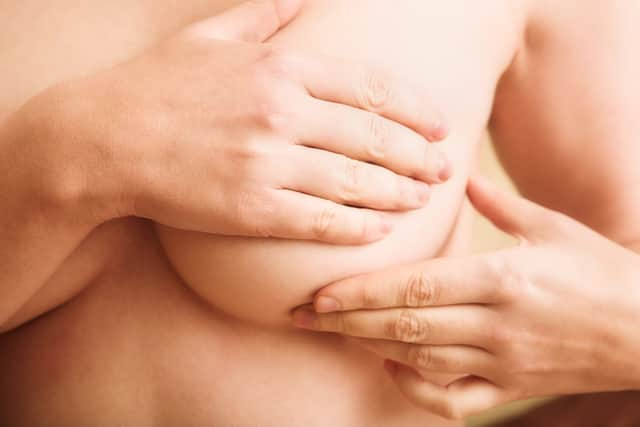Breast cancer: signs and symptoms of condition, treatment options and how to check your breasts - explained
and live on Freeview channel 276
About one in seven women are diagnosed with breast cancer during their lifetime, but there’s a good chance of recovery if it’s detected at an early stage, according to the NHS.
In rare cases, men can also be diagnosed with breast cancer.


Advertisement
Hide AdAdvertisement
Hide AdBut what are the symptoms of breast cancer in women, what treatment options are available and how should you check your breasts?
Here’s everything you need to know.
What are the symptoms of breast cancer?
Breast cancer can have several symptoms, but the first noticeable symptom is usually a lump or area of thickened breast tissue.
Most breast lumps are not cancerous, but it’s always best to have them checked by a doctor.
You should see a GP if you notice any of these symptoms:
- a change in the size, outline or shape of one or both breasts
- discharge from either of your nipples, which may be streaked with blood
- a new lump, swelling, thickening or bumpy area in one breast or armpit that was not there before
- a change in the look or feel of the skin on your breast, such as puckering or dimpling, a rash or redness
- a rash (like eczema), crusting, scaly or itchy skin or redness on or around your nipple
- a change in the appearance of your nipple, such as becoming sunken into your breast or any change in nipple position, such a your nipple being pulled in or pointing differently
- any discomfort or pain in one breast, particularly if it’s a new pain and does not go away (although pain is only a symptom of breast cancer in rare cases)
What are the causes of breast cancer?
The exact causes of breast cancer are not fully understood, but there are certain factors known to increase the risk of breast cancer, including:
- age – the risk increases as you get older
- a family history of breast cancer
- a previous diagnosis of breast cancer
- a previous non-cancerous (benign) breast lump
- being tall, overweight or obese
- drinking alcohol
How is breast cancer diagnosed?
Advertisement
Hide AdAdvertisement
Hide AdAfter examining your breasts, a GP may refer you to a specialist breast cancer clinic for further tests.
This might include breast screening (mammography) or taking a small sample of breast tissue to be examined under a microscope (a biopsy).
As the risk of breast cancer increases with age, all women who are 50 to 70 years old are invited for routine breast cancer screening every three years.
Women over the age of 70 are also entitled to screening and can arrange an appointment through their GP or local screening unit.
Advertisement
Hide AdAdvertisement
Hide AdThe NHS is also in the process of extending the programme as a trial, offering screening to some women aged 47 to 73.
How is breast cancer treated?
If cancer is detected at an early stage, it can be treated before it spreads to other parts of the body.
Breast cancer is treated using a combination of:
- surgery
- chemotherapy
- radiotherapy
Surgery is usually the first type of treatment you’ll have, followed by chemotherapy or radiotherapy. In some cases, you may receive hormone or targeted treatments.
The type of surgery and the treatment you have afterwards will depend on the type of breast cancer you have, but your doctor will discuss the best treatment plan with you.
Advertisement
Hide AdAdvertisement
Hide AdIn a small proportion of women, breast cancer is discovered after it’s spread to other parts of the body (metastatic breast cancer).
Secondary cancer, also called advanced or metastatic cancer, is not curable, so the aim of treatment is to relieve symptoms.
How should I check my breasts?
It’s vital that women check their breasts regularly for any changes and always have any changes examined by a GP.
Every woman’s breasts are different in terms of size, shape and consistency, and it’s also possible for one breast to be larger than the other.
Advertisement
Hide AdAdvertisement
Hide AdYou should get used to how your breasts feel at different times of the month as this can change during your menstrual cycle.
After the menopause, normal breasts feel softer, less firm and not as lumpy.
You should look at your breasts and feel each breast and armpit, and up to your collarbone.
You may find it easiest to do this in the shower or bath, by running a soapy hand over each breast and up under each armpit.
You can also look at your breasts in the mirror. You should look with your arms by your side and also with them raised.
Comment Guidelines
National World encourages reader discussion on our stories. User feedback, insights and back-and-forth exchanges add a rich layer of context to reporting. Please review our Community Guidelines before commenting.